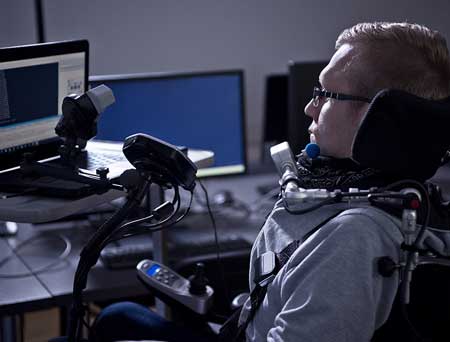Online + accessibility = inclusion

TECHNOLOGY
You can no doubt relate to how it feels when you’re scanning through links within text and half of them don’t work. Or your friend sends you a link to a cool podcast but, when you load it up, you can’t hear the speaker over the background noise.
As a listener, you likely got frustrated and decided to move on to something easier on your ears (and your patience). Seamless user experiences are often something we take for granted, but facing barriers to retrieving online content can be a common experience for people with disabilities.
The key difference? If you’re just annoyed or frustrated by a site, you can probably still get information from it, or choose to find something else. But what if you need that information, from that source – right now! – and can’t access it properly? If it wasn’t designed with accessibility in mind, this would not be a matter of choice
Assistive technologies help break access barriers
As businesses and organizations have focused on providing virtual services and information many workplaces are already learning how to implement ways for individuals to control and customize their experience. But universal access is about more than just adding closed captioning for persons who are hard of hearing, or about adding control buttons for those wanting to jump through an audio presentation.
People may also bring their own tools to help them access online content (you may notice some now come built-in with your systems), such as software for:
- Screen reading – which reads out loud what’s onscreen, announcing navigation elements
- Speech recognition – which will follow spoken commands from the user or type out their dictated words
- Screen magnification – which makes part or all of a screen larger so that words or images are easier to see
If you’ve ever needed your vision corrected, think about the difference you felt the first time you donned those new glasses or contact lenses. You suddenly could see things you’d maybe missed before, in their full array of light and colour!
Eliminating barriers to access is an integral step toward diversity, inclusion and belonging. The key goal is for everyone, no matter their situation, to have the same experience using the “glasses” that work for them.
(Dis)ability is a spectrum
According to Accessibility Services Canada, accessible information serves the needs of people with “vision, motor and cognitive impairments.” This concept acknowledges that the need for help navigating content exists on a spectrum. For example:
- Think of the “brain fog” experienced by people with fibromyalgia, severe food intolerances and even temporary “pregnancy brain.”
- Consider visual perception impairments, including colour blindness, migraines, or dry eyes due to menopause.
- Remember that some of us process information differently and need plain-language information that’s broken into shorter, more manageable units.
While this list is by no means exhaustive, maybe you already recognize yourself here or know someone whose needs can be overlooked in the design of online content.
Work on universal online access spans decades
The need for universal access has gained political traction, but it has been on the minds of information designers practically since the Internet began:
1995: Initial guidelines are drafted about making an “Information Superhighway” that works for everyone.
2005: The Accessibility for Ontarians with Disabilities Act (AODA) is the first provincial act of its kind to become law, with other provinces following in later years. Compliance is encouraged in stages, depending on the type and size of organization. This is in response to research and guidelines for coding and writing web content by the World Wide Web Consortium through its Web Content Accessibility Guidelines (WCAG).
AODA guidelines require that documents and content be updated so that people are able to navigate websites using technologies that make browsing possible beyond looking at the screen or clicking a mouse.
2008: The most recent set of approved WCAG guidelines and checkpoints is released, updating the 1999 version 1.0.
2019: The federal Accessible Canada Act goes into effect.
2021: All websites and web content were required to comply with WCAG 2.0 level AA to meet AODA requirements by January 1.
With more training and building our understanding, Canadian workforces are coming together to create a more inclusive experience, no matter how online information is used.
Learn more
- Watch a YouTube demo of how a screen reader speaks out website text
- Here’s a similar demo, this time with a Word document – hear the difference between how the screen
reader processes an accessible versus an inaccessible Word file - Read more about how people with disabilities use the Web
- Learn about the AODA from Accessibility Services Canada
Excerpts of this article are republished from CPA Canada’s Diversity, Equity and Inclusion series.
Disclaimer
The information provided on this page is intended to provide general information. The information does not take into account your personal situation and is not intended to be used without consultation from accounting and financial professionals. Allan Madan and Madan Chartered Accountant will not be held liable for any problems that arise from the usage of the information provided on this page.


SOCIAL CONNECT